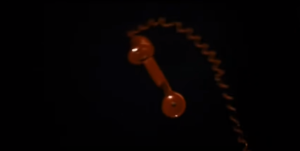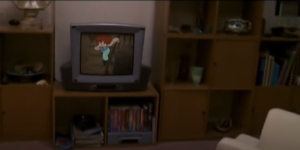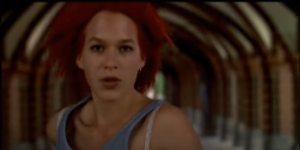Run Lola Run retains narrative momentum by both establishing its metaphysical defiance early and by using an array of compositions, camera movements, and types of cuts to weave its images into continuity. Most obvious is the use of the “red phone” image, which slams itself down upon reset of each timeline.

It also repeats an animation and the event of Lola scrambling down the apartment hallway at the beginning. It is not enough to merely repeat the events, however- the composition and camera movements are meticulously imitated, invoking that sense of Deja-vu as the timelines reset and converge. The camera diverges from Lola at the end of the hall, sweeping into a new room where an elderly woman speaking on the phone becomes our new subject. In one timeline, we glide right past her and into the television; As the narrative becomes more frantic, the camera spins erratically before entering the television. As we become more entrenched in the repeated rules and cinematic gestures of the timeline, the film becomes more comfortable breaking them.

One of the more fascinating edits in the movie sees Lola sprinting, the frame interrupted by pillars splitting the image, and occasionally we intercut for a fractional second and see Lola’s face as she runs. A cut is a way to conceal many things, but in this case it is a dilation of time- Run Lola Run frequently manipulate geography with cutting, but these cuts also switch the shots from wide to close, allowing a greater emotional insight and distressing tone.

Run Lola Run is a dense example of the way cutting, composition, images, and editing can allow an audience to understand the spatial and temporal manipulation of a story.